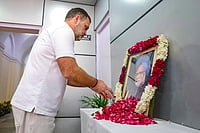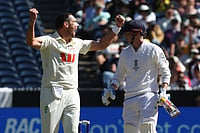Novelist, translator, food author and historian—Chitrita Banerji has donned several hats. She is a well-known, respected personality in food-writing circles, having penned several critically acclaimed works such as Life and Food in Bengal (1991), The Hour of the Goddess: Memories of Women, Food, and Ritual in Bengal (2001), Land of Milk and Honey: Travels in the History of Indian Food (2007) and Eating India: An Odyssey into the Food and Culture of the Land of Spices (2007). Her books blend together memory, history, culture, religion and lived experiences in refreshing, thought-provoking ways, as anyone acquainted with these works will attest to.
At long last, Banerji published her memoir, A Taste of My Life: A Memoir in Essay and Recipes, in December 2021. In a recent conversation, Banerji spoke to Outlook Traveller about her book, and more.
A Taste of My Life: A Memoir in Essay and Recipes consists of a number of essays that have been published elsewhere before. Tell us a bit about why you chose to revisit the essays for this book now. Since the book is centred around heartwarming, wholesome anecdotes, was there any such similar motivating tale behind crafting and compiling the book?
No, there was no such tale. I had been asked a few times to consider writing a memoir and didn’t think it would be possible. However, when I re-read some of these earlier pieces, it suddenly came to me that they highlight significant times and experiences I could arrange to form a representation of my life, which could serve as a memoir.
Among the many dishes and food items you have mentioned throughout the book, which ones do you have the softest spot for? Similarly, among the many stories you narrate, which ones do you have the fondest recollections of?
It is always hard to choose a particular dish over others. However, among the ones included in this book, I would probably say that mochar ghanto and Kadam Bhai’s duck bhuna are particular favorites of mine. As for the stories, some are more dramatic and action-filled than others. For readers, those might be the more arresting ones. For me, however, it is the quiet and reflective passages of life that leave a more lingering trace. So if I have to choose, I would say “Pleasure in a Cone,” the story about paan, and “Green Noodles by the River,” the story about my time in Bangladesh.
Broadly speaking, three interconnecting threads seem to be woven into the text: food, memories and this sense of people and family coming together and bonding over the former two in unconventional ways. How dependent would your choice of a ‘favourite dish’ be on your memories of it and the people associated with it? Would you say it is possible for one to choose a beloved dish without associating it, whatsoever, to people and/or personal/shared memories?
That depends on the person. For me, most dishes that I love tend to have strong personal associations—either with a character, or a place, or an event. But it is entirely possible to relish a dish and remember it simply on its merits. For instance, I mention in the book a preparation I had in Bangladesh, a piece of hilsa baked into a savoury rice-flour pitha. That has no association with a special person or circumstance, yet it remains in my mind as an unforgettable, eclectic pleasure.

Memories, as one knows, tend to often be unstructured and follow no definite sequence or pattern. What was interesting to me, therefore, was your choice to present your memoir as a meal course, which, as we know, has a rigid sequence, in Bengali eating traditions as well. Was there any particular reason for you to bring this contrast alive in your book? And what accounts for the unusually stunning clarity of the episodes you recount in this book?
No particular reason. It just struck me, since this was not going to be a regular memoir of continuous text, but an assembly of pieces highlighting events and experiences, it needed to be curated in an unusual way. What better [way] than to structure it like a menu? Yes, Bengali meals are traditionally very structured, but so are meals in other cultures. I wasn’t trying to stress the structure of Bengali meals in particular. As for clarity, if you mean the details recounted in the essays, I suppose that is because I was motivated to write about incidents or people who are deeply etched in my mind.
What Indian or Bengali dishes do you miss the most, especially if they are impossible to make or come across in the US? Similarly, are there any Indian establishments (restaurants, eateries, dhabas, etc.), in Bengal or elsewhere, past or present, that you miss sorely in the US?
There is a lot to miss. The flavours of fruits and vegetables, even if technically the same, are very different from what you can get in Bengal/India. It is a question of terroir. I particularly miss some fishes that were my favorites when I lived in Calcutta. In the US, as in many western countries, it is seafood that is both plentiful and widely eaten. For Bengalis used to eating freshwater fish, the initial reaction to seafood can be a profound shock. I have now grown used to some of the fish you can buy here, but none of them provides the same kind of delight and satisfaction as the Bengali varieties I have loved. As for eateries, although I have enjoyed food in many places, I have no nostalgia for them. When it comes to missing something, it always comes down to food I have had either at my parents’ home or the homes of friends and relatives.
What are the similarities and dissimilarities that you have observed between culinary and eating aesthetics and sensibilities you have seen between Bengalis and people in the US? I am thinking more along the lines of attitudes people have towards food, their habits, rather than those stemming from a difference in sources and varieties of food. As someone who has been a part of both worlds, currently, which side of the spectrum do you identify with more? Or, is it more a case of harmonious coexistence?
I suppose “harmonious coexistence” is not a bad way to describe how I feel. Although there is always a deep-seated longing for Bengali food inside me, I have experienced a wide variety of cuisines during my time in the US and in other countries. I have been fortunate to expand my tastes and learn to love many kinds of food that were not part of my heritage. As for attitudes toward food, I think there is a kind of universality that you see in people of all places and ethnicities. Variations in preference and attitude do exist in individuals, but those are generated by economic conditions, some traditional beliefs, exposure to other cultures, and access to different foods.
In your personal experience, how have eating habits, aesthetics and culinary traditions evolved in Bengal and the US over the course of the period you have charted out in A Taste of My Life? How do you see these habits and traditions evolving in both regions in the future?
The most notable trend is the effect of globalisation and availability of information, especially through the internet. In Bengal, as in the rest of India, popular tastes have evolved to include a widespread interest in the cuisines of different parts of the world. Not only that, there is considerable awareness and appreciation of the regional nuances of non-Indian food. Restaurants and bakeries serving such foods are proliferating and consumers are responding with eagerness. One can almost assume that this will lead to the demise of deep-rooted traditions of eating, yet, happily that is not so. There are many people who are promoting distinctive foods of each region and making them available to consumers. I hope this happy balance will continue. In the US, too, there is a constantly growing awareness of the rich culinary heritage of different parts of the world, along with a determination to learn about the foods of lesser-known communities within the country.
Have you ever travelled to Bengal, the US, or any other place just for the sake of finding a food item or tasting a particular dish, and no other reason besides? Could you describe that experience for us?
No, I can’t say I have done that.
Tell us a bit about your most fulfilling and memorable culinary/food-hunting journeys in the Indian subcontinent.
One such experience was in Ahmedabad. I arrived there knowing no one. I did have the phone number of a journalist working for a local newspaper—and when I met him and explained that I was doing some research on food in Gujarat, he called someone he knew. Much to my surprise, that gentleman asked me to take a cab and come over to his place right then. I went, thinking I would meet him and, maybe, his wife, have a cup of tea, and get some information about what to look for and what to eat. Instead, I encountered a delightful, deeply knowledgeable person, full of enthusiasm about the food and traditions of his region. His wife was equally delightful, and they both insisted I stay and have lunch with them. I still remember him saying, “You won’t just be eating Gujarati food, you will be learning how to eat it.” I have never forgotten that meal—not simply because it was both delicious and included items I had never tasted before, but because of the joyous hospitality that enveloped me.

This must have been among your most deeply personal efforts till date. Personally, I was extremely moved by each of the chapters that so evocatively bridged the gap between food, memories and lived experiences. What does this book mean to you? And what would you expect to be the key takeaways for your readers from it?
Your question reminds me of the first and last sentences of T. S. Eliot’s poem, "East Coker", which is one of the Four Quartets: “In my beginning is my end ... In my end is my beginning.” The circularity of time and memory is something we all experience—it is connected to the desire to revisit and better understand the past which overtakes us from time to time. I think this book is rooted in that experience. For readers, too, this phenomenon may determine how the book affects them. I hope that it will stimulate introspection and perhaps lead to new perceptions about food and life.

























